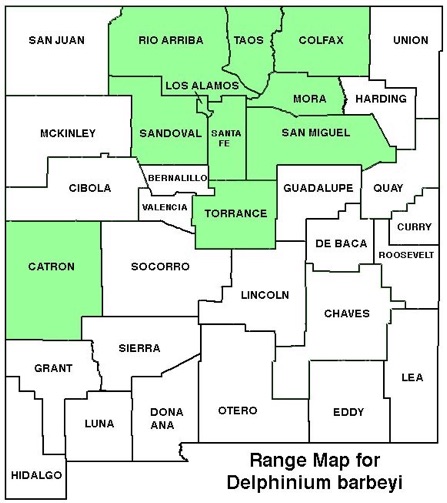WILDFLOWERS OF NEW MEXICO

Towering, unbranched stems 4–6 feet tall, and covered with sticky glandular hairs, cover wet slopes and mountain meadows with spikes of dark blue to purple flowers. Note the spur at the rear of the flowers, and the large rounded leaf blades with 5–9 radiating lobes. White-flowered and bicolored specimens occur. The plant contains highly toxic alkaloid compounds. Also called Barbey’s Larkspur.
FLOWER: June–September. Spike-like clusters (racemes) have glandular-hairy stems and 10–50 hairy flowers; each flower has 5 showy petal-like purple sepals, the upper one forms a spur 3/8–3/4 inch long (10–18 mm), pointing upward, and often with a hooked tip; 2 small, white upper petals unite to form a small tube that leads into the spur and guides long-tongued insects to the nectar glands at the tip of the spur; 2 hairy, blue, lower petals cover the stamens. Fruit is an erect bundle of cylindrical capsules with pointed tips.
LEAVES: Alternate; leaf stems (petioles) to 5 1/2 inches long (14 cm). Blades rounded, to 5 inches long (13 cm), with 5–9 radiating lobes, each divided again and lined with pointed teeth. Blades and petioles get smaller up the stem.
HABITAT: Moist soils of meadows, slopes, open forests, stream sides; spruce-fir, aspen forests, subalpine and alpine meadows.
ELEVATION: 8,000–12,600 feet.
RANGE: AZ, CO, NM, UT, WY.
SIMILAR SPECIES: This is common blue larkspur taller that 3 feet within its range in NM. Rocky Mountain Larkspur, D. scopulorum has basal leaves at time of blooming. Mountain Larkspur, D. ramosum, has lower petals densely covered with white hairs. Dwarf Larkspur, D. nuttallainum, is only 6–12 inches tall. White Mountain Larkspur, D. novomexicanum is endemic to the Sacramento and White mountains in southern NM.
NM COUNTIES: Northern and central mountains of NM in high-elevation, moist habitats: Catron, Colfax, Los Alamos, Mora, Rio Arriba, San Miguel, Sandoval, Santa Fe, Taos, Torrance.

SUBALPINE (TALL) LARKSPUR
DELPHINIUM BARBEYI
Buttercup Family, Ranunculaceae
Perennial herb



THE CONTENTS OF THIS WEBSITE ARE COPYRIGHTED AND CANNOT BE USED
WITHOUT PERMISSION OF GEORGE OXFORD MILLER
EMAIL ME

5 pointed, purple, petal-like sepals surround 2 white upper petals (upper arrow) and 2 hairy lower purple petals (lower arrow) that cover the stamens.



The upper sepal forms a long spur that contains the nectar glands at the end. Only long-tongued insects like moths and bumble bees can reach the nectar.
Each glandular-hairy stem has a flower cluster with 10–50 hairy blooms.
Leaves have 5–9 radiating lobes, each divided into toothed segments.

Plants with white or bicolored flowers occur rarely.
